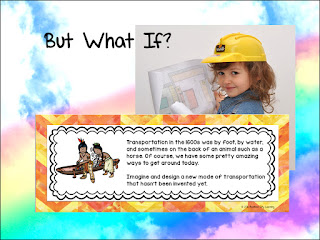Have you tried any STEM or STEAM lessons yet in your classroom? Do you have a school or classroom Maker Space? Are you making plans for next year, hoping to raise the bar on your STEAM program?
STEAM lessons and projects are really the ultimate Project Based Learning experiences, with application to authentic real world issues. Where to begin?
I recommend starting out in the sandbox, where we build our basic knowledge and develop a playlist of things we can try when we are in the midst of a larger project. We all start out as toddlers experimenting in real sandboxes, building castles, making moats, and moving sand from one location to another. I like to think of basic STEM activities as Sandbox STEAM. These basic activities are great warmups to the kind of maker challenges that upper elementary students should be engaged in. Even the Arts, an integral part of STEAM in my opinion, has it's beginning in early sandbox play. Imagination and role play that so often accompanies sandbox time for our littlest learners is an early precursor of drama, writing, and visual experiences to come.
Most of the STEM experiences that you see and may have tried are great for team building, an introduction to STEM, and a way to develop some basic engineering skills. We love these short in and out activities. Kids love them too! They are hands on, something different, and fun. Most of them involve the construction of domes, towers, bridges, and mazes. They challenge kids to create movement through the use of catapults, floating, and dropping. They encourage teamwork in moving objects across short distances. All of these basic skills, once introduced and practiced, can increase the knowledge base when kids tackle larger and real world problems.
Everyone knows that fun task of saving a cute little gummy worm named Fred or Sam or whatever. You and your friends need to user paper clips and move him from the "water" to the "boat" without touching him with hands. Kids love using candy to complete any assignment. Even teachers enjoy doing this one the most at conference sessions I've presented. But WHAT IF... What if we applied our skill in saving Fred to developing a new device to be used by lifeguards (or family or friends or bystanders) in a real life drowning emergency? What if kids could imagine a new piece of equipment that could be used on personal and recreational watercraft to be prepared for water rescue situations?
We love, love, love to build catapults from craft sticks, rubber bands, and plastic spoons. We love chucking those pumpkins across the room. But WHAT IF... What if the skills we developed there could be translated into a research-based investigation of possibilities for air and space travel. What if kids moved from chucking candy pumpkins across the classroom to developing an innovation for the farming industry?
Floating foil boats to see how many pennies each boat can hold before submerging is certainly fun. But once and done? I hope not. What if observations and skills from this activity could be applied to a longer project to develop new flotation devices or even innovations for boat construction for shipping companies and the armed forces?
I hope you can see my theme here: Basic STEM activities can open the doors of learning and innovation for so many larger STEAM investigations. Take any basic STEM activity that you have already done or are planning to do soon. Ask your students to imagine WHAT IF and to suggest
larger investigations that can be based on the basics learned in the activity.
If you are looking for more basic, warm up STEM activities, you may want to take a look at this resource from Rainbow City Learning's STEM/STEAM category
For more April ideas, be sure to check out these posts from our Teacher Talk blogging group! Only group members may add their links here. If you'd like to join our group, please email me at: retta.london@gmail.com



























Nice post with a lot of ideas to take STEM activities to the next level. Thank you for sharing!
ReplyDeleteVery helpful post. Makes it sound easy to integrate into your curriculum. I truly love hands on activities. Thanks so much for your suggestions.
ReplyDeleteI like these ideas. Thanks for sharing these great STEM activities!
ReplyDelete